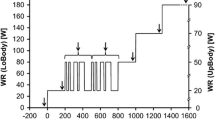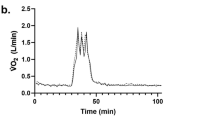Abstract
The concept of the accumulated O2 deficit (AOD) assumes that the O2 deficit increases monotonically with increasing work rate (WR), to plateau at the maximum AOD, and is based on linear extrapolation of the relationship between measured steady-state oxygen uptake (V̇O2) and WR for moderate exercise. However, for high WRs, the measured V̇O2 increases above that expected from such linear extrapolation, reflecting the superimposition of a "slow component" on the fundamental V̇O2 mono-exponential kinetics. We were therefore interested in determining the effect of the V̇O2 slow component on the computed AOD. Ten subjects [31 (12) years] performed square-wave cycle ergometry of moderate (40%, 60%, 80% and 90% \( {\hat{\theta }_{{\rm{L}}} } \)), heavy (40%Δ), very heavy (80%Δ) and severe (110% V̇O2 peak) intensities for 10–15 min, where \( {\hat{\theta }_{{\rm{L}}} } \) is the estimated lactate threshold and Δ is the WR difference between \( {\hat{\theta }_{{\rm{L}}} } \) and V̇O2 peak. V̇O2 was determined breath-by-breath. Projected "steady-state" V̇O2 values were determined from sub-\( {\hat{\theta }_{{\rm{L}}} } \) tests. The measured V̇O2 exceeded the projected value after ~3 min for both heavy and very heavy intensity exercise. This led to the AOD actually becoming negative. Thus, for heavy exercise, while the AOD was positive [0.63 (0.41) l] at 5 min, it was negative by 10 min [−0.61 (1.05) l], and more so by 15 min [−1.70 (1.64) l]. For the very heavy WRs, the AOD was [0.42 (0.67) l] by 5 min and reached −2.68 (2.09) l at exhaustion. For severe exercise, however, the AOD at exhaustion was positive in each case: +1.69 (0.39) l. We therefore conclude that the assumptions underlying the computation of the AOD are invalid for heavy and very heavy cycle ergometry (at least). Physiological inferences, such as the "anaerobic work capacity", are therefore prone to misinterpretation.





Similar content being viewed by others
References
Antonutto G, Di Prampero PE (1995) The concept of lactate threshold. A short review. J Sports Med Phys Fitness 35(1):6–12
Bangsbo J (2000) Muscle oxygen uptake in humans at onset of and during intense exercise. Acta Physiol Scand 168(4):457–464
Bangsbo J, Gollnick PD, Graham TE, Juel C, Kiens B, Mizuno M, Saltin B (1990) Anaerobic energy production and O2 deficit-debt relationship during exhaustive exercise in humans. J Physiol (Lond) 422:539–559
Barstow TJ, Molé PA (1991) Linear and non-linear characteristics of oxygen uptake during heavy exercise. J Appl Physiol 71:2099–2106
Bearden SE, Moffatt RJ (2000) V̇O2 kinetics and the O2 deficit in heavy exercise.J Appl Physiol 88:1407–1412
Beaver WL, Wasserman K, Whipp BJ (1973) On-line computer analysis and breath-by-breath graphical display of exercise function tests. J Appl Physiol 34:128–132
Borrani F, Candau R, Perrey S, Millet GY, Millet GP, Rouillon JD (2003) Does the mechanical work in running change during the V̇O2 slow component? Med Sci Sports Exerc 35(1):50–57
Carter H, Pringle JS, Jones AM, Doust JH (2002) Oxygen uptake kinetics during treadmill running across exercise intensity domains. Eur J Appl Physiol 86(4):347–354
Cerretelli P, di Prampero PE (1987) Gas exchange in exercise. In: Fishman (ed) Handbook of Physiology, vol IV. American Physiological Society, Bethesda, Md., pp 297–340
Demarie S, Sardella F, Billat V, Magini W, Faina M (2001) The V̇O2 slow component in swimming. Eur J Appl Physiol 84(1–2):95–99
di Prampero PE (1981) Energetics of muscular exercise. Rev Physiol Biochem Pharmacol 89:143–222
Hill DW, Poole DC, Smith JC (2002) The relationship between power and the time to achieve V̇O2 max. Med Sci Sports Exerc 34(4):709–714
Hughson RL, Tschakovsky ME (1999) Cardiovascular dynamics at the onset of exercise. Med Sci Sports Exerc 31(7):1005–1010
Krogh A, Lindhard J (1913) The regulation of respiration and circulation during the initial stages of muscular work. J Physiol (Lond) 47:112–136
Langsetmo I, Weigle GE, Fedde MR, Erickson HH, Barstow TJ, Poole DC (1997) VO2 kinetics in the horse during moderate and heavy exercise. J Appl Physiol 83(4):1235–1241
Linarsson D (1974) Dynamics of pulmonary gas exchange and heart rate changes at the start and end of exercise. Acta Physiol Scand Suppl 414:1–68
Medbø JI, Mohn A, Tabata I, Bahr R, Vaage O, Sejersted OM (1988) Anaerobic capacity determined by maximal accumulated O2 deficit. J Appl Physiol 64(1):50–60
Özyener F, Rossiter HB, Ward SA, Whipp BJ (2001) Influence of exercise intensity on the on- and off-transient kinetics of pulmonary oxygen uptake kinetics in humans. J Physiol (Lond) 533(3):891–902
Paterson DH, Whipp BJ (1991) Asymmetries of oxygen uptake transients at the on-and offset of heavy exercise in humans. J Physiol (Lond) 443:575–586
Rossiter HB, Ward SA, Kowalchuk JM, Howe FA, Griffiths JR, Whipp BJ (2002) Dynamic asymmetry of phosphocreatine concentration and O2 uptake between the on- and off-transients of moderate- and high-intensity exercise in humans. J Physiol (Lond) 541:991–1002
Weber CL, Schneider DA (2001) Reliability of MAOD measured at 110% and 120% of peak oxygen uptake for cycling. Med Sci Sports Exerc 33(6):1056–1059
Whipp BJ (1994) The slow component of O2 uptake kinetics during heavy exercise. Med Sci Sports Exerc 26(11):1319–1326
Whipp BJ (1996) Domains of aerobic function and their limiting parameters. In: Steinacker JM, Ward SA (eds) The physiology and pathophysiology of exercise tolerance, Chapter 12. Plenum, New York, pp 83–89
Whipp BJ, Özyener F (1998) The kinetics of exertional oxygen uptake: assumptions and inferences. Med Dello Sport 51:139–149
Whipp BJ, Wasserman K, Ward SA (1986) Respiratory markers of the anaerobic threshold. Adv Cardiol 35:47–64
Withers RT, Sherman WM, Clark DG, Esselbach PC, Nolan SR, Mackay MH, Brinkman M (1991) Muscle metabolism during 30, 60 and 90 s of maximal cycling on a air-braked ergometer. Eur J Appl Physiol 63:354–362
Acknowledgement
H.B.R. is supported by a Wellcome Trust (UK) International Prize Travelling Fellowship (064898).
Author information
Authors and Affiliations
Corresponding author
Rights and permissions
About this article
Cite this article
Özyener, F., Rossiter, H.B., Ward, S.A. et al. Negative accumulated oxygen deficit during heavy and very heavy intensity cycle ergometry in humans. Eur J Appl Physiol 90, 185–190 (2003). https://doi.org/10.1007/s00421-003-0870-y
Accepted:
Published:
Issue Date:
DOI: https://doi.org/10.1007/s00421-003-0870-y




